There are many native types of ground cover from which to choose. These offer the additional benefits of ease of care and adaptability to the local weather, soil conditions, and resistance to certain wild animals. Whatever kinds of ground cover you have in your landscape, make it simple to grow and relatively carefree. Here are some of my favorite kinds of ground cover for every garden.
Choosing the Best Ground Cover Plants
The best ground cover plants offer year-round beauty and effortless greenery. Evergreen plants provide foliage even in winter, while flowering, perennial ground covers offer much-needed color, often early in the growing season. Growth rate is also an important factor – if you are after the fastest growing ground cover, thyme and ajuga can grow several feet per year once established. When selecting from different types of ground cover plants, you should also consider site, soil type, sun exposure, amount of maintenance and hardiness.
1. Sedum
There are around 400-500 species of sedum plants. These easy-to-grow, sun-loving plants come in both erect and prostrate forms. Sedum Sunsparkler ‘Blue Elf’ is a stonecrop variety that grows just three inches (8cm) in height. The thickened, rounded leaves are a delightful blue-green hue. In late summer through early fall, the plant produces hot pink, starry flower clusters held above the foliage on slightly longer stems. The flowers are attractive to many pollinators and emit a subtle, pleasant fragrance. This stonecrop can tolerate almost any soil and is drought-tolerant once it is established.
2. Creeping Phlox
Another ground cover that develops flowers that bring in the pollinators, creeping phlox also has evergreen leaves that are deeply green, oval and pointed at the tips. ‘Sherwood Purple’ is a variety that is slow-growing and is tolerant of partial to full shade. The flowers arrive in spring and have five deeply purple petals with a yellow-orange center. Few pests or insects bother this creeping phlox, and it is even tolerant of moist soil.
3. Marsh Marigold
Unlike annual marigolds, marsh marigolds are perennials in the buttercup family. Sometimes called cowslip, kingcup or cowflock, these ground cover plants are native to North America. They are riparian plants, found in nature along streams and rivers. The plant forms a dense mat over time and will be filled with sweet, yellow flowers in early spring. Marsh marigold prefers moist soil and is a pollinator magnet and cover for wild creatures, while also being deer resistant.
4. Lilyturf
This is another evergreen ground cover selection that produces grass-like clumps of foliage. There are variegated, green and blue options. Creeping lilyturf is an aggressive spreader and is best used where a large area needs ground cover. Purple flower spikes appear in mid to late summer. The plant tolerates both full sun and part shade. It likes well-draining soil which is moderately moist but not soggy. Some gardeners mow it back in early spring to allow new growth to colonize the site.
5. Bugleweed
Ajuga (aka bugleweed) is hardy to USDA zone 4. It has purple-bronze leaves that produce the best color in lower light sites. Bugleweed spreads slowly, but will produce new plants through underground runners. In spring, it develops a dense mat of foliage topped by bright purple flowers. Ajuga grows three-eight inches (8-20cm) in height. It thrives in moist soils, but can tolerate brief periods of dryness.
6. Creeping Juniper
This is one of the old-fashioned, classic types of ground cover plants. An evergreen, creeping juniper comes in several varieties. There is a blue form, as well as green and even gold. The scale-like foliage is dense and few weeds can survive under its canopy. Native to North America, the plant is found in inhospitable soils and sites. It prefers full sun and is tolerant of hot, dry weather once established. It is also deer resistant and adaptable to salt sites. Small, round cones appear at the end of the growing season.
7. Candytuft
One of the earliest blooming plants in spring, candytuft is an evergreen, perennial ground cover plant. It will spread fairly fast, scrambling over rocky or soiled sites. When you grow candytuft, bear in mind it needs well draining soil and full sun. In early spring, the plant is a mass of white blooms, heralding the start of the growing season. Many pollinators enjoy the nectar of the flowers of these ground cover plants, which are hardy to -30°F (-34°C).
8. Japanese Sedge
This ground cover plant is partially evergreen, depending on your zone. Perfect for a shady or partially shady location, Japanese sedge is a clump-forming plant with grass-like blades. It is a cool-season grass and goes semi-dormant when the heat of summer begins. This sedge is deer and rabbit resistant and prefers moist soil of almost any type. There are green and variegated varieties such as Ice Dance.
9. Cotoneaster
Tiny, rounded, evergreen leaves decorate this plant’s arching stems. In spring, it produces small, white or blush flowers, followed by red berries. While cotoneaster comes in many forms, most are only two feet (60m) high at maturity. The plant thrives in full sun or partial shade, growing slowly for the first couple of years, but rapidly increasing growth thereafter. The plant may be pruned to keep it in a certain size or form.
10. Flowering Thyme
Not only does creeping flowering thyme stay evergreen, but it releases a heady herbal fragrance when crushed. Thyme is very cold tolerant, to -20°F (-29°C). The plant will be heavily adorned with reddish-purple flowers in spring. It is deer-resistant and grows up to three inches (8cm) in height when mature. Thyme is moderately tolerant of light foot traffic and turns into a carpet of charming little leaves in no time. This article features products available from third party vendors on the Gardening Know How Shop. Plant Mother of Thyme seeds from Park Seeds for a carpet of color that thrives in poor soils as long as they are well draining. Its dense growth habit is ideal for edible garden edgings, terraces and rockeries.
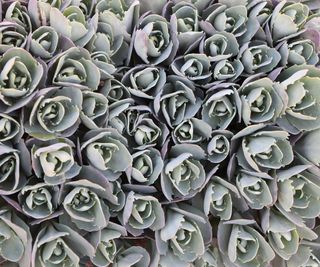
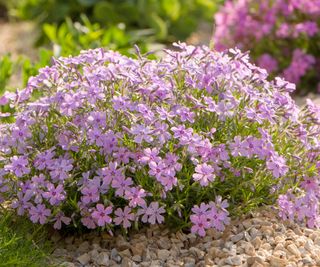
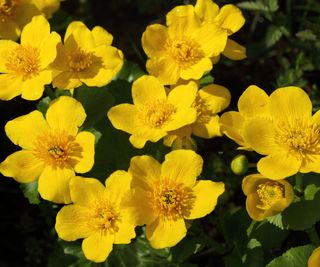
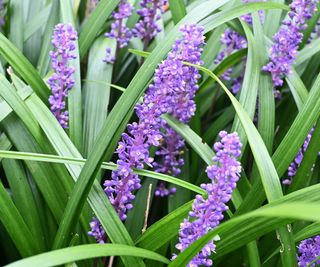
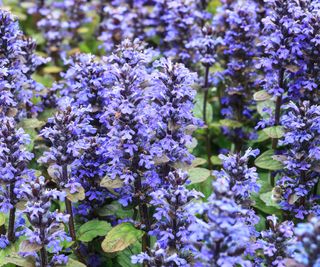
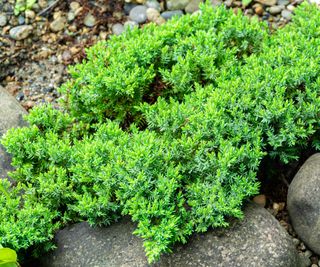
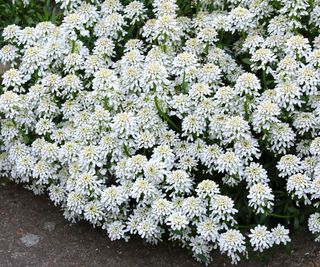
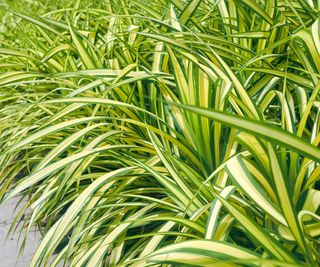
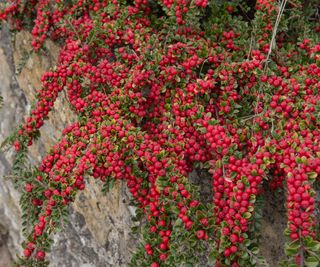
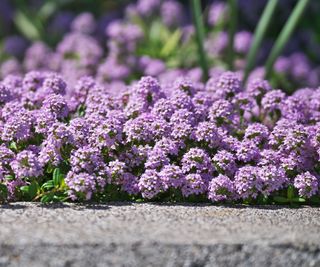
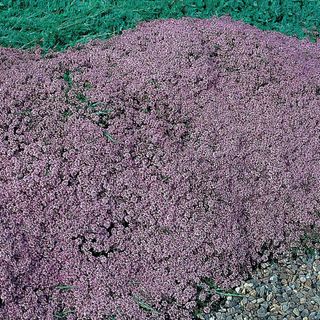
title: “10 Easygoing Ground Cover Plants For Every Garden” ShowToc: true date: “2024-10-02” author: “Shirley Bishop”
There are many native types of ground cover from which to choose. These offer the additional benefits of ease of care and adaptability to the local weather, soil conditions, and resistance to certain wild animals. Whatever kinds of ground cover you have in your landscape, make it simple to grow and relatively carefree. Here are some of my favorite kinds of ground cover for every garden.
Choosing the Best Ground Cover Plants
The best ground cover plants offer year-round beauty and effortless greenery. Evergreen plants provide foliage even in winter, while flowering, perennial ground covers offer much-needed color, often early in the growing season. Growth rate is also an important factor – if you are after the fastest growing ground cover, thyme and ajuga can grow several feet per year once established. When selecting from different types of ground cover plants, you should also consider site, soil type, sun exposure, amount of maintenance and hardiness.
1. Sedum
There are around 400-500 species of sedum plants. These easy-to-grow, sun-loving plants come in both erect and prostrate forms. Sedum Sunsparkler ‘Blue Elf’ is a stonecrop variety that grows just three inches (8cm) in height. The thickened, rounded leaves are a delightful blue-green hue. In late summer through early fall, the plant produces hot pink, starry flower clusters held above the foliage on slightly longer stems. The flowers are attractive to many pollinators and emit a subtle, pleasant fragrance. This stonecrop can tolerate almost any soil and is drought-tolerant once it is established.
2. Creeping Phlox
Another ground cover that develops flowers that bring in the pollinators, creeping phlox also has evergreen leaves that are deeply green, oval and pointed at the tips. ‘Sherwood Purple’ is a variety that is slow-growing and is tolerant of partial to full shade. The flowers arrive in spring and have five deeply purple petals with a yellow-orange center. Few pests or insects bother this creeping phlox, and it is even tolerant of moist soil.
3. Marsh Marigold
Unlike annual marigolds, marsh marigolds are perennials in the buttercup family. Sometimes called cowslip, kingcup or cowflock, these ground cover plants are native to North America. They are riparian plants, found in nature along streams and rivers. The plant forms a dense mat over time and will be filled with sweet, yellow flowers in early spring. Marsh marigold prefers moist soil and is a pollinator magnet and cover for wild creatures, while also being deer resistant.
4. Lilyturf
This is another evergreen ground cover selection that produces grass-like clumps of foliage. There are variegated, green and blue options. Creeping lilyturf is an aggressive spreader and is best used where a large area needs ground cover. Purple flower spikes appear in mid to late summer. The plant tolerates both full sun and part shade. It likes well-draining soil which is moderately moist but not soggy. Some gardeners mow it back in early spring to allow new growth to colonize the site.
5. Bugleweed
Ajuga (aka bugleweed) is hardy to USDA zone 4. It has purple-bronze leaves that produce the best color in lower light sites. Bugleweed spreads slowly, but will produce new plants through underground runners. In spring, it develops a dense mat of foliage topped by bright purple flowers. Ajuga grows three-eight inches (8-20cm) in height. It thrives in moist soils, but can tolerate brief periods of dryness.
6. Creeping Juniper
This is one of the old-fashioned, classic types of ground cover plants. An evergreen, creeping juniper comes in several varieties. There is a blue form, as well as green and even gold. The scale-like foliage is dense and few weeds can survive under its canopy. Native to North America, the plant is found in inhospitable soils and sites. It prefers full sun and is tolerant of hot, dry weather once established. It is also deer resistant and adaptable to salt sites. Small, round cones appear at the end of the growing season.
7. Candytuft
One of the earliest blooming plants in spring, candytuft is an evergreen, perennial ground cover plant. It will spread fairly fast, scrambling over rocky or soiled sites. When you grow candytuft, bear in mind it needs well draining soil and full sun. In early spring, the plant is a mass of white blooms, heralding the start of the growing season. Many pollinators enjoy the nectar of the flowers of these ground cover plants, which are hardy to -30°F (-34°C).
8. Japanese Sedge
This ground cover plant is partially evergreen, depending on your zone. Perfect for a shady or partially shady location, Japanese sedge is a clump-forming plant with grass-like blades. It is a cool-season grass and goes semi-dormant when the heat of summer begins. This sedge is deer and rabbit resistant and prefers moist soil of almost any type. There are green and variegated varieties such as Ice Dance.
9. Cotoneaster
Tiny, rounded, evergreen leaves decorate this plant’s arching stems. In spring, it produces small, white or blush flowers, followed by red berries. While cotoneaster comes in many forms, most are only two feet (60m) high at maturity. The plant thrives in full sun or partial shade, growing slowly for the first couple of years, but rapidly increasing growth thereafter. The plant may be pruned to keep it in a certain size or form.
10. Flowering Thyme
Not only does creeping flowering thyme stay evergreen, but it releases a heady herbal fragrance when crushed. Thyme is very cold tolerant, to -20°F (-29°C). The plant will be heavily adorned with reddish-purple flowers in spring. It is deer-resistant and grows up to three inches (8cm) in height when mature. Thyme is moderately tolerant of light foot traffic and turns into a carpet of charming little leaves in no time. This article features products available from third party vendors on the Gardening Know How Shop. Plant Mother of Thyme seeds from Park Seeds for a carpet of color that thrives in poor soils as long as they are well draining. Its dense growth habit is ideal for edible garden edgings, terraces and rockeries.











title: “10 Easygoing Ground Cover Plants For Every Garden” ShowToc: true date: “2024-10-07” author: “Claire Henry”
There are many native types of ground cover from which to choose. These offer the additional benefits of ease of care and adaptability to the local weather, soil conditions, and resistance to certain wild animals. Whatever kinds of ground cover you have in your landscape, make it simple to grow and relatively carefree. Here are some of my favorite kinds of ground cover for every garden.
Choosing the Best Ground Cover Plants
The best ground cover plants offer year-round beauty and effortless greenery. Evergreen plants provide foliage even in winter, while flowering, perennial ground covers offer much-needed color, often early in the growing season. Growth rate is also an important factor – if you are after the fastest growing ground cover, thyme and ajuga can grow several feet per year once established. When selecting from different types of ground cover plants, you should also consider site, soil type, sun exposure, amount of maintenance and hardiness.
1. Sedum
There are around 400-500 species of sedum plants. These easy-to-grow, sun-loving plants come in both erect and prostrate forms. Sedum Sunsparkler ‘Blue Elf’ is a stonecrop variety that grows just three inches (8cm) in height. The thickened, rounded leaves are a delightful blue-green hue. In late summer through early fall, the plant produces hot pink, starry flower clusters held above the foliage on slightly longer stems. The flowers are attractive to many pollinators and emit a subtle, pleasant fragrance. This stonecrop can tolerate almost any soil and is drought-tolerant once it is established.
2. Creeping Phlox
Another ground cover that develops flowers that bring in the pollinators, creeping phlox also has evergreen leaves that are deeply green, oval and pointed at the tips. ‘Sherwood Purple’ is a variety that is slow-growing and is tolerant of partial to full shade. The flowers arrive in spring and have five deeply purple petals with a yellow-orange center. Few pests or insects bother this creeping phlox, and it is even tolerant of moist soil.
3. Marsh Marigold
Unlike annual marigolds, marsh marigolds are perennials in the buttercup family. Sometimes called cowslip, kingcup or cowflock, these ground cover plants are native to North America. They are riparian plants, found in nature along streams and rivers. The plant forms a dense mat over time and will be filled with sweet, yellow flowers in early spring. Marsh marigold prefers moist soil and is a pollinator magnet and cover for wild creatures, while also being deer resistant.
4. Lilyturf
This is another evergreen ground cover selection that produces grass-like clumps of foliage. There are variegated, green and blue options. Creeping lilyturf is an aggressive spreader and is best used where a large area needs ground cover. Purple flower spikes appear in mid to late summer. The plant tolerates both full sun and part shade. It likes well-draining soil which is moderately moist but not soggy. Some gardeners mow it back in early spring to allow new growth to colonize the site.
5. Bugleweed
Ajuga (aka bugleweed) is hardy to USDA zone 4. It has purple-bronze leaves that produce the best color in lower light sites. Bugleweed spreads slowly, but will produce new plants through underground runners. In spring, it develops a dense mat of foliage topped by bright purple flowers. Ajuga grows three-eight inches (8-20cm) in height. It thrives in moist soils, but can tolerate brief periods of dryness.
6. Creeping Juniper
This is one of the old-fashioned, classic types of ground cover plants. An evergreen, creeping juniper comes in several varieties. There is a blue form, as well as green and even gold. The scale-like foliage is dense and few weeds can survive under its canopy. Native to North America, the plant is found in inhospitable soils and sites. It prefers full sun and is tolerant of hot, dry weather once established. It is also deer resistant and adaptable to salt sites. Small, round cones appear at the end of the growing season.
7. Candytuft
One of the earliest blooming plants in spring, candytuft is an evergreen, perennial ground cover plant. It will spread fairly fast, scrambling over rocky or soiled sites. When you grow candytuft, bear in mind it needs well draining soil and full sun. In early spring, the plant is a mass of white blooms, heralding the start of the growing season. Many pollinators enjoy the nectar of the flowers of these ground cover plants, which are hardy to -30°F (-34°C).
8. Japanese Sedge
This ground cover plant is partially evergreen, depending on your zone. Perfect for a shady or partially shady location, Japanese sedge is a clump-forming plant with grass-like blades. It is a cool-season grass and goes semi-dormant when the heat of summer begins. This sedge is deer and rabbit resistant and prefers moist soil of almost any type. There are green and variegated varieties such as Ice Dance.
9. Cotoneaster
Tiny, rounded, evergreen leaves decorate this plant’s arching stems. In spring, it produces small, white or blush flowers, followed by red berries. While cotoneaster comes in many forms, most are only two feet (60m) high at maturity. The plant thrives in full sun or partial shade, growing slowly for the first couple of years, but rapidly increasing growth thereafter. The plant may be pruned to keep it in a certain size or form.
10. Flowering Thyme
Not only does creeping flowering thyme stay evergreen, but it releases a heady herbal fragrance when crushed. Thyme is very cold tolerant, to -20°F (-29°C). The plant will be heavily adorned with reddish-purple flowers in spring. It is deer-resistant and grows up to three inches (8cm) in height when mature. Thyme is moderately tolerant of light foot traffic and turns into a carpet of charming little leaves in no time. This article features products available from third party vendors on the Gardening Know How Shop. Plant Mother of Thyme seeds from Park Seeds for a carpet of color that thrives in poor soils as long as they are well draining. Its dense growth habit is ideal for edible garden edgings, terraces and rockeries.











title: “10 Easygoing Ground Cover Plants For Every Garden” ShowToc: true date: “2024-09-16” author: “Brandy Ibrahim”
There are many native types of ground cover from which to choose. These offer the additional benefits of ease of care and adaptability to the local weather, soil conditions, and resistance to certain wild animals. Whatever kinds of ground cover you have in your landscape, make it simple to grow and relatively carefree. Here are some of my favorite kinds of ground cover for every garden.
Choosing the Best Ground Cover Plants
The best ground cover plants offer year-round beauty and effortless greenery. Evergreen plants provide foliage even in winter, while flowering, perennial ground covers offer much-needed color, often early in the growing season. Growth rate is also an important factor – if you are after the fastest growing ground cover, thyme and ajuga can grow several feet per year once established. When selecting from different types of ground cover plants, you should also consider site, soil type, sun exposure, amount of maintenance and hardiness.
1. Sedum
There are around 400-500 species of sedum plants. These easy-to-grow, sun-loving plants come in both erect and prostrate forms. Sedum Sunsparkler ‘Blue Elf’ is a stonecrop variety that grows just three inches (8cm) in height. The thickened, rounded leaves are a delightful blue-green hue. In late summer through early fall, the plant produces hot pink, starry flower clusters held above the foliage on slightly longer stems. The flowers are attractive to many pollinators and emit a subtle, pleasant fragrance. This stonecrop can tolerate almost any soil and is drought-tolerant once it is established.
2. Creeping Phlox
Another ground cover that develops flowers that bring in the pollinators, creeping phlox also has evergreen leaves that are deeply green, oval and pointed at the tips. ‘Sherwood Purple’ is a variety that is slow-growing and is tolerant of partial to full shade. The flowers arrive in spring and have five deeply purple petals with a yellow-orange center. Few pests or insects bother this creeping phlox, and it is even tolerant of moist soil.
3. Marsh Marigold
Unlike annual marigolds, marsh marigolds are perennials in the buttercup family. Sometimes called cowslip, kingcup or cowflock, these ground cover plants are native to North America. They are riparian plants, found in nature along streams and rivers. The plant forms a dense mat over time and will be filled with sweet, yellow flowers in early spring. Marsh marigold prefers moist soil and is a pollinator magnet and cover for wild creatures, while also being deer resistant.
4. Lilyturf
This is another evergreen ground cover selection that produces grass-like clumps of foliage. There are variegated, green and blue options. Creeping lilyturf is an aggressive spreader and is best used where a large area needs ground cover. Purple flower spikes appear in mid to late summer. The plant tolerates both full sun and part shade. It likes well-draining soil which is moderately moist but not soggy. Some gardeners mow it back in early spring to allow new growth to colonize the site.
5. Bugleweed
Ajuga (aka bugleweed) is hardy to USDA zone 4. It has purple-bronze leaves that produce the best color in lower light sites. Bugleweed spreads slowly, but will produce new plants through underground runners. In spring, it develops a dense mat of foliage topped by bright purple flowers. Ajuga grows three-eight inches (8-20cm) in height. It thrives in moist soils, but can tolerate brief periods of dryness.
6. Creeping Juniper
This is one of the old-fashioned, classic types of ground cover plants. An evergreen, creeping juniper comes in several varieties. There is a blue form, as well as green and even gold. The scale-like foliage is dense and few weeds can survive under its canopy. Native to North America, the plant is found in inhospitable soils and sites. It prefers full sun and is tolerant of hot, dry weather once established. It is also deer resistant and adaptable to salt sites. Small, round cones appear at the end of the growing season.
7. Candytuft
One of the earliest blooming plants in spring, candytuft is an evergreen, perennial ground cover plant. It will spread fairly fast, scrambling over rocky or soiled sites. When you grow candytuft, bear in mind it needs well draining soil and full sun. In early spring, the plant is a mass of white blooms, heralding the start of the growing season. Many pollinators enjoy the nectar of the flowers of these ground cover plants, which are hardy to -30°F (-34°C).
8. Japanese Sedge
This ground cover plant is partially evergreen, depending on your zone. Perfect for a shady or partially shady location, Japanese sedge is a clump-forming plant with grass-like blades. It is a cool-season grass and goes semi-dormant when the heat of summer begins. This sedge is deer and rabbit resistant and prefers moist soil of almost any type. There are green and variegated varieties such as Ice Dance.
9. Cotoneaster
Tiny, rounded, evergreen leaves decorate this plant’s arching stems. In spring, it produces small, white or blush flowers, followed by red berries. While cotoneaster comes in many forms, most are only two feet (60m) high at maturity. The plant thrives in full sun or partial shade, growing slowly for the first couple of years, but rapidly increasing growth thereafter. The plant may be pruned to keep it in a certain size or form.
10. Flowering Thyme
Not only does creeping flowering thyme stay evergreen, but it releases a heady herbal fragrance when crushed. Thyme is very cold tolerant, to -20°F (-29°C). The plant will be heavily adorned with reddish-purple flowers in spring. It is deer-resistant and grows up to three inches (8cm) in height when mature. Thyme is moderately tolerant of light foot traffic and turns into a carpet of charming little leaves in no time. This article features products available from third party vendors on the Gardening Know How Shop. Plant Mother of Thyme seeds from Park Seeds for a carpet of color that thrives in poor soils as long as they are well draining. Its dense growth habit is ideal for edible garden edgings, terraces and rockeries.











title: “10 Easygoing Ground Cover Plants For Every Garden” ShowToc: true date: “2024-10-08” author: “Shirley Rottman”
There are many native types of ground cover from which to choose. These offer the additional benefits of ease of care and adaptability to the local weather, soil conditions, and resistance to certain wild animals. Whatever kinds of ground cover you have in your landscape, make it simple to grow and relatively carefree. Here are some of my favorite kinds of ground cover for every garden.
Choosing the Best Ground Cover Plants
The best ground cover plants offer year-round beauty and effortless greenery. Evergreen plants provide foliage even in winter, while flowering, perennial ground covers offer much-needed color, often early in the growing season. Growth rate is also an important factor – if you are after the fastest growing ground cover, thyme and ajuga can grow several feet per year once established. When selecting from different types of ground cover plants, you should also consider site, soil type, sun exposure, amount of maintenance and hardiness.
1. Sedum
There are around 400-500 species of sedum plants. These easy-to-grow, sun-loving plants come in both erect and prostrate forms. Sedum Sunsparkler ‘Blue Elf’ is a stonecrop variety that grows just three inches (8cm) in height. The thickened, rounded leaves are a delightful blue-green hue. In late summer through early fall, the plant produces hot pink, starry flower clusters held above the foliage on slightly longer stems. The flowers are attractive to many pollinators and emit a subtle, pleasant fragrance. This stonecrop can tolerate almost any soil and is drought-tolerant once it is established.
2. Creeping Phlox
Another ground cover that develops flowers that bring in the pollinators, creeping phlox also has evergreen leaves that are deeply green, oval and pointed at the tips. ‘Sherwood Purple’ is a variety that is slow-growing and is tolerant of partial to full shade. The flowers arrive in spring and have five deeply purple petals with a yellow-orange center. Few pests or insects bother this creeping phlox, and it is even tolerant of moist soil.
3. Marsh Marigold
Unlike annual marigolds, marsh marigolds are perennials in the buttercup family. Sometimes called cowslip, kingcup or cowflock, these ground cover plants are native to North America. They are riparian plants, found in nature along streams and rivers. The plant forms a dense mat over time and will be filled with sweet, yellow flowers in early spring. Marsh marigold prefers moist soil and is a pollinator magnet and cover for wild creatures, while also being deer resistant.
4. Lilyturf
This is another evergreen ground cover selection that produces grass-like clumps of foliage. There are variegated, green and blue options. Creeping lilyturf is an aggressive spreader and is best used where a large area needs ground cover. Purple flower spikes appear in mid to late summer. The plant tolerates both full sun and part shade. It likes well-draining soil which is moderately moist but not soggy. Some gardeners mow it back in early spring to allow new growth to colonize the site.
5. Bugleweed
Ajuga (aka bugleweed) is hardy to USDA zone 4. It has purple-bronze leaves that produce the best color in lower light sites. Bugleweed spreads slowly, but will produce new plants through underground runners. In spring, it develops a dense mat of foliage topped by bright purple flowers. Ajuga grows three-eight inches (8-20cm) in height. It thrives in moist soils, but can tolerate brief periods of dryness.
6. Creeping Juniper
This is one of the old-fashioned, classic types of ground cover plants. An evergreen, creeping juniper comes in several varieties. There is a blue form, as well as green and even gold. The scale-like foliage is dense and few weeds can survive under its canopy. Native to North America, the plant is found in inhospitable soils and sites. It prefers full sun and is tolerant of hot, dry weather once established. It is also deer resistant and adaptable to salt sites. Small, round cones appear at the end of the growing season.
7. Candytuft
One of the earliest blooming plants in spring, candytuft is an evergreen, perennial ground cover plant. It will spread fairly fast, scrambling over rocky or soiled sites. When you grow candytuft, bear in mind it needs well draining soil and full sun. In early spring, the plant is a mass of white blooms, heralding the start of the growing season. Many pollinators enjoy the nectar of the flowers of these ground cover plants, which are hardy to -30°F (-34°C).
8. Japanese Sedge
This ground cover plant is partially evergreen, depending on your zone. Perfect for a shady or partially shady location, Japanese sedge is a clump-forming plant with grass-like blades. It is a cool-season grass and goes semi-dormant when the heat of summer begins. This sedge is deer and rabbit resistant and prefers moist soil of almost any type. There are green and variegated varieties such as Ice Dance.
9. Cotoneaster
Tiny, rounded, evergreen leaves decorate this plant’s arching stems. In spring, it produces small, white or blush flowers, followed by red berries. While cotoneaster comes in many forms, most are only two feet (60m) high at maturity. The plant thrives in full sun or partial shade, growing slowly for the first couple of years, but rapidly increasing growth thereafter. The plant may be pruned to keep it in a certain size or form.
10. Flowering Thyme
Not only does creeping flowering thyme stay evergreen, but it releases a heady herbal fragrance when crushed. Thyme is very cold tolerant, to -20°F (-29°C). The plant will be heavily adorned with reddish-purple flowers in spring. It is deer-resistant and grows up to three inches (8cm) in height when mature. Thyme is moderately tolerant of light foot traffic and turns into a carpet of charming little leaves in no time. This article features products available from third party vendors on the Gardening Know How Shop. Plant Mother of Thyme seeds from Park Seeds for a carpet of color that thrives in poor soils as long as they are well draining. Its dense growth habit is ideal for edible garden edgings, terraces and rockeries.











title: “10 Easygoing Ground Cover Plants For Every Garden” ShowToc: true date: “2024-09-21” author: “Robert Wilson”
There are many native types of ground cover from which to choose. These offer the additional benefits of ease of care and adaptability to the local weather, soil conditions, and resistance to certain wild animals. Whatever kinds of ground cover you have in your landscape, make it simple to grow and relatively carefree. Here are some of my favorite kinds of ground cover for every garden.
Choosing the Best Ground Cover Plants
The best ground cover plants offer year-round beauty and effortless greenery. Evergreen plants provide foliage even in winter, while flowering, perennial ground covers offer much-needed color, often early in the growing season. Growth rate is also an important factor – if you are after the fastest growing ground cover, thyme and ajuga can grow several feet per year once established. When selecting from different types of ground cover plants, you should also consider site, soil type, sun exposure, amount of maintenance and hardiness.
1. Sedum
There are around 400-500 species of sedum plants. These easy-to-grow, sun-loving plants come in both erect and prostrate forms. Sedum Sunsparkler ‘Blue Elf’ is a stonecrop variety that grows just three inches (8cm) in height. The thickened, rounded leaves are a delightful blue-green hue. In late summer through early fall, the plant produces hot pink, starry flower clusters held above the foliage on slightly longer stems. The flowers are attractive to many pollinators and emit a subtle, pleasant fragrance. This stonecrop can tolerate almost any soil and is drought-tolerant once it is established.
2. Creeping Phlox
Another ground cover that develops flowers that bring in the pollinators, creeping phlox also has evergreen leaves that are deeply green, oval and pointed at the tips. ‘Sherwood Purple’ is a variety that is slow-growing and is tolerant of partial to full shade. The flowers arrive in spring and have five deeply purple petals with a yellow-orange center. Few pests or insects bother this creeping phlox, and it is even tolerant of moist soil.
3. Marsh Marigold
Unlike annual marigolds, marsh marigolds are perennials in the buttercup family. Sometimes called cowslip, kingcup or cowflock, these ground cover plants are native to North America. They are riparian plants, found in nature along streams and rivers. The plant forms a dense mat over time and will be filled with sweet, yellow flowers in early spring. Marsh marigold prefers moist soil and is a pollinator magnet and cover for wild creatures, while also being deer resistant.
4. Lilyturf
This is another evergreen ground cover selection that produces grass-like clumps of foliage. There are variegated, green and blue options. Creeping lilyturf is an aggressive spreader and is best used where a large area needs ground cover. Purple flower spikes appear in mid to late summer. The plant tolerates both full sun and part shade. It likes well-draining soil which is moderately moist but not soggy. Some gardeners mow it back in early spring to allow new growth to colonize the site.
5. Bugleweed
Ajuga (aka bugleweed) is hardy to USDA zone 4. It has purple-bronze leaves that produce the best color in lower light sites. Bugleweed spreads slowly, but will produce new plants through underground runners. In spring, it develops a dense mat of foliage topped by bright purple flowers. Ajuga grows three-eight inches (8-20cm) in height. It thrives in moist soils, but can tolerate brief periods of dryness.
6. Creeping Juniper
This is one of the old-fashioned, classic types of ground cover plants. An evergreen, creeping juniper comes in several varieties. There is a blue form, as well as green and even gold. The scale-like foliage is dense and few weeds can survive under its canopy. Native to North America, the plant is found in inhospitable soils and sites. It prefers full sun and is tolerant of hot, dry weather once established. It is also deer resistant and adaptable to salt sites. Small, round cones appear at the end of the growing season.
7. Candytuft
One of the earliest blooming plants in spring, candytuft is an evergreen, perennial ground cover plant. It will spread fairly fast, scrambling over rocky or soiled sites. When you grow candytuft, bear in mind it needs well draining soil and full sun. In early spring, the plant is a mass of white blooms, heralding the start of the growing season. Many pollinators enjoy the nectar of the flowers of these ground cover plants, which are hardy to -30°F (-34°C).
8. Japanese Sedge
This ground cover plant is partially evergreen, depending on your zone. Perfect for a shady or partially shady location, Japanese sedge is a clump-forming plant with grass-like blades. It is a cool-season grass and goes semi-dormant when the heat of summer begins. This sedge is deer and rabbit resistant and prefers moist soil of almost any type. There are green and variegated varieties such as Ice Dance.
9. Cotoneaster
Tiny, rounded, evergreen leaves decorate this plant’s arching stems. In spring, it produces small, white or blush flowers, followed by red berries. While cotoneaster comes in many forms, most are only two feet (60m) high at maturity. The plant thrives in full sun or partial shade, growing slowly for the first couple of years, but rapidly increasing growth thereafter. The plant may be pruned to keep it in a certain size or form.
10. Flowering Thyme
Not only does creeping flowering thyme stay evergreen, but it releases a heady herbal fragrance when crushed. Thyme is very cold tolerant, to -20°F (-29°C). The plant will be heavily adorned with reddish-purple flowers in spring. It is deer-resistant and grows up to three inches (8cm) in height when mature. Thyme is moderately tolerant of light foot traffic and turns into a carpet of charming little leaves in no time. This article features products available from third party vendors on the Gardening Know How Shop. Plant Mother of Thyme seeds from Park Seeds for a carpet of color that thrives in poor soils as long as they are well draining. Its dense growth habit is ideal for edible garden edgings, terraces and rockeries.











title: “10 Easygoing Ground Cover Plants For Every Garden” ShowToc: true date: “2024-10-18” author: “Raymond Stobie”
There are many native types of ground cover from which to choose. These offer the additional benefits of ease of care and adaptability to the local weather, soil conditions, and resistance to certain wild animals. Whatever kinds of ground cover you have in your landscape, make it simple to grow and relatively carefree. Here are some of my favorite kinds of ground cover for every garden.
Choosing the Best Ground Cover Plants
The best ground cover plants offer year-round beauty and effortless greenery. Evergreen plants provide foliage even in winter, while flowering, perennial ground covers offer much-needed color, often early in the growing season. Growth rate is also an important factor – if you are after the fastest growing ground cover, thyme and ajuga can grow several feet per year once established. When selecting from different types of ground cover plants, you should also consider site, soil type, sun exposure, amount of maintenance and hardiness.
1. Sedum
There are around 400-500 species of sedum plants. These easy-to-grow, sun-loving plants come in both erect and prostrate forms. Sedum Sunsparkler ‘Blue Elf’ is a stonecrop variety that grows just three inches (8cm) in height. The thickened, rounded leaves are a delightful blue-green hue. In late summer through early fall, the plant produces hot pink, starry flower clusters held above the foliage on slightly longer stems. The flowers are attractive to many pollinators and emit a subtle, pleasant fragrance. This stonecrop can tolerate almost any soil and is drought-tolerant once it is established.
2. Creeping Phlox
Another ground cover that develops flowers that bring in the pollinators, creeping phlox also has evergreen leaves that are deeply green, oval and pointed at the tips. ‘Sherwood Purple’ is a variety that is slow-growing and is tolerant of partial to full shade. The flowers arrive in spring and have five deeply purple petals with a yellow-orange center. Few pests or insects bother this creeping phlox, and it is even tolerant of moist soil.
3. Marsh Marigold
Unlike annual marigolds, marsh marigolds are perennials in the buttercup family. Sometimes called cowslip, kingcup or cowflock, these ground cover plants are native to North America. They are riparian plants, found in nature along streams and rivers. The plant forms a dense mat over time and will be filled with sweet, yellow flowers in early spring. Marsh marigold prefers moist soil and is a pollinator magnet and cover for wild creatures, while also being deer resistant.
4. Lilyturf
This is another evergreen ground cover selection that produces grass-like clumps of foliage. There are variegated, green and blue options. Creeping lilyturf is an aggressive spreader and is best used where a large area needs ground cover. Purple flower spikes appear in mid to late summer. The plant tolerates both full sun and part shade. It likes well-draining soil which is moderately moist but not soggy. Some gardeners mow it back in early spring to allow new growth to colonize the site.
5. Bugleweed
Ajuga (aka bugleweed) is hardy to USDA zone 4. It has purple-bronze leaves that produce the best color in lower light sites. Bugleweed spreads slowly, but will produce new plants through underground runners. In spring, it develops a dense mat of foliage topped by bright purple flowers. Ajuga grows three-eight inches (8-20cm) in height. It thrives in moist soils, but can tolerate brief periods of dryness.
6. Creeping Juniper
This is one of the old-fashioned, classic types of ground cover plants. An evergreen, creeping juniper comes in several varieties. There is a blue form, as well as green and even gold. The scale-like foliage is dense and few weeds can survive under its canopy. Native to North America, the plant is found in inhospitable soils and sites. It prefers full sun and is tolerant of hot, dry weather once established. It is also deer resistant and adaptable to salt sites. Small, round cones appear at the end of the growing season.
7. Candytuft
One of the earliest blooming plants in spring, candytuft is an evergreen, perennial ground cover plant. It will spread fairly fast, scrambling over rocky or soiled sites. When you grow candytuft, bear in mind it needs well draining soil and full sun. In early spring, the plant is a mass of white blooms, heralding the start of the growing season. Many pollinators enjoy the nectar of the flowers of these ground cover plants, which are hardy to -30°F (-34°C).
8. Japanese Sedge
This ground cover plant is partially evergreen, depending on your zone. Perfect for a shady or partially shady location, Japanese sedge is a clump-forming plant with grass-like blades. It is a cool-season grass and goes semi-dormant when the heat of summer begins. This sedge is deer and rabbit resistant and prefers moist soil of almost any type. There are green and variegated varieties such as Ice Dance.
9. Cotoneaster
Tiny, rounded, evergreen leaves decorate this plant’s arching stems. In spring, it produces small, white or blush flowers, followed by red berries. While cotoneaster comes in many forms, most are only two feet (60m) high at maturity. The plant thrives in full sun or partial shade, growing slowly for the first couple of years, but rapidly increasing growth thereafter. The plant may be pruned to keep it in a certain size or form.
10. Flowering Thyme
Not only does creeping flowering thyme stay evergreen, but it releases a heady herbal fragrance when crushed. Thyme is very cold tolerant, to -20°F (-29°C). The plant will be heavily adorned with reddish-purple flowers in spring. It is deer-resistant and grows up to three inches (8cm) in height when mature. Thyme is moderately tolerant of light foot traffic and turns into a carpet of charming little leaves in no time. This article features products available from third party vendors on the Gardening Know How Shop. Plant Mother of Thyme seeds from Park Seeds for a carpet of color that thrives in poor soils as long as they are well draining. Its dense growth habit is ideal for edible garden edgings, terraces and rockeries.











title: “10 Easygoing Ground Cover Plants For Every Garden” ShowToc: true date: “2024-09-23” author: “Elias Freeman”
There are many native types of ground cover from which to choose. These offer the additional benefits of ease of care and adaptability to the local weather, soil conditions, and resistance to certain wild animals. Whatever kinds of ground cover you have in your landscape, make it simple to grow and relatively carefree. Here are some of my favorite kinds of ground cover for every garden.
Choosing the Best Ground Cover Plants
The best ground cover plants offer year-round beauty and effortless greenery. Evergreen plants provide foliage even in winter, while flowering, perennial ground covers offer much-needed color, often early in the growing season. Growth rate is also an important factor – if you are after the fastest growing ground cover, thyme and ajuga can grow several feet per year once established. When selecting from different types of ground cover plants, you should also consider site, soil type, sun exposure, amount of maintenance and hardiness.
1. Sedum
There are around 400-500 species of sedum plants. These easy-to-grow, sun-loving plants come in both erect and prostrate forms. Sedum Sunsparkler ‘Blue Elf’ is a stonecrop variety that grows just three inches (8cm) in height. The thickened, rounded leaves are a delightful blue-green hue. In late summer through early fall, the plant produces hot pink, starry flower clusters held above the foliage on slightly longer stems. The flowers are attractive to many pollinators and emit a subtle, pleasant fragrance. This stonecrop can tolerate almost any soil and is drought-tolerant once it is established.
2. Creeping Phlox
Another ground cover that develops flowers that bring in the pollinators, creeping phlox also has evergreen leaves that are deeply green, oval and pointed at the tips. ‘Sherwood Purple’ is a variety that is slow-growing and is tolerant of partial to full shade. The flowers arrive in spring and have five deeply purple petals with a yellow-orange center. Few pests or insects bother this creeping phlox, and it is even tolerant of moist soil.
3. Marsh Marigold
Unlike annual marigolds, marsh marigolds are perennials in the buttercup family. Sometimes called cowslip, kingcup or cowflock, these ground cover plants are native to North America. They are riparian plants, found in nature along streams and rivers. The plant forms a dense mat over time and will be filled with sweet, yellow flowers in early spring. Marsh marigold prefers moist soil and is a pollinator magnet and cover for wild creatures, while also being deer resistant.
4. Lilyturf
This is another evergreen ground cover selection that produces grass-like clumps of foliage. There are variegated, green and blue options. Creeping lilyturf is an aggressive spreader and is best used where a large area needs ground cover. Purple flower spikes appear in mid to late summer. The plant tolerates both full sun and part shade. It likes well-draining soil which is moderately moist but not soggy. Some gardeners mow it back in early spring to allow new growth to colonize the site.
5. Bugleweed
Ajuga (aka bugleweed) is hardy to USDA zone 4. It has purple-bronze leaves that produce the best color in lower light sites. Bugleweed spreads slowly, but will produce new plants through underground runners. In spring, it develops a dense mat of foliage topped by bright purple flowers. Ajuga grows three-eight inches (8-20cm) in height. It thrives in moist soils, but can tolerate brief periods of dryness.
6. Creeping Juniper
This is one of the old-fashioned, classic types of ground cover plants. An evergreen, creeping juniper comes in several varieties. There is a blue form, as well as green and even gold. The scale-like foliage is dense and few weeds can survive under its canopy. Native to North America, the plant is found in inhospitable soils and sites. It prefers full sun and is tolerant of hot, dry weather once established. It is also deer resistant and adaptable to salt sites. Small, round cones appear at the end of the growing season.
7. Candytuft
One of the earliest blooming plants in spring, candytuft is an evergreen, perennial ground cover plant. It will spread fairly fast, scrambling over rocky or soiled sites. When you grow candytuft, bear in mind it needs well draining soil and full sun. In early spring, the plant is a mass of white blooms, heralding the start of the growing season. Many pollinators enjoy the nectar of the flowers of these ground cover plants, which are hardy to -30°F (-34°C).
8. Japanese Sedge
This ground cover plant is partially evergreen, depending on your zone. Perfect for a shady or partially shady location, Japanese sedge is a clump-forming plant with grass-like blades. It is a cool-season grass and goes semi-dormant when the heat of summer begins. This sedge is deer and rabbit resistant and prefers moist soil of almost any type. There are green and variegated varieties such as Ice Dance.
9. Cotoneaster
Tiny, rounded, evergreen leaves decorate this plant’s arching stems. In spring, it produces small, white or blush flowers, followed by red berries. While cotoneaster comes in many forms, most are only two feet (60m) high at maturity. The plant thrives in full sun or partial shade, growing slowly for the first couple of years, but rapidly increasing growth thereafter. The plant may be pruned to keep it in a certain size or form.
10. Flowering Thyme
Not only does creeping flowering thyme stay evergreen, but it releases a heady herbal fragrance when crushed. Thyme is very cold tolerant, to -20°F (-29°C). The plant will be heavily adorned with reddish-purple flowers in spring. It is deer-resistant and grows up to three inches (8cm) in height when mature. Thyme is moderately tolerant of light foot traffic and turns into a carpet of charming little leaves in no time. This article features products available from third party vendors on the Gardening Know How Shop. Plant Mother of Thyme seeds from Park Seeds for a carpet of color that thrives in poor soils as long as they are well draining. Its dense growth habit is ideal for edible garden edgings, terraces and rockeries.











title: “10 Easygoing Ground Cover Plants For Every Garden” ShowToc: true date: “2024-09-02” author: “Carolyn Flores”
There are many native types of ground cover from which to choose. These offer the additional benefits of ease of care and adaptability to the local weather, soil conditions, and resistance to certain wild animals. Whatever kinds of ground cover you have in your landscape, make it simple to grow and relatively carefree. Here are some of my favorite kinds of ground cover for every garden.
Choosing the Best Ground Cover Plants
The best ground cover plants offer year-round beauty and effortless greenery. Evergreen plants provide foliage even in winter, while flowering, perennial ground covers offer much-needed color, often early in the growing season. Growth rate is also an important factor – if you are after the fastest growing ground cover, thyme and ajuga can grow several feet per year once established. When selecting from different types of ground cover plants, you should also consider site, soil type, sun exposure, amount of maintenance and hardiness.
1. Sedum
There are around 400-500 species of sedum plants. These easy-to-grow, sun-loving plants come in both erect and prostrate forms. Sedum Sunsparkler ‘Blue Elf’ is a stonecrop variety that grows just three inches (8cm) in height. The thickened, rounded leaves are a delightful blue-green hue. In late summer through early fall, the plant produces hot pink, starry flower clusters held above the foliage on slightly longer stems. The flowers are attractive to many pollinators and emit a subtle, pleasant fragrance. This stonecrop can tolerate almost any soil and is drought-tolerant once it is established.
2. Creeping Phlox
Another ground cover that develops flowers that bring in the pollinators, creeping phlox also has evergreen leaves that are deeply green, oval and pointed at the tips. ‘Sherwood Purple’ is a variety that is slow-growing and is tolerant of partial to full shade. The flowers arrive in spring and have five deeply purple petals with a yellow-orange center. Few pests or insects bother this creeping phlox, and it is even tolerant of moist soil.
3. Marsh Marigold
Unlike annual marigolds, marsh marigolds are perennials in the buttercup family. Sometimes called cowslip, kingcup or cowflock, these ground cover plants are native to North America. They are riparian plants, found in nature along streams and rivers. The plant forms a dense mat over time and will be filled with sweet, yellow flowers in early spring. Marsh marigold prefers moist soil and is a pollinator magnet and cover for wild creatures, while also being deer resistant.
4. Lilyturf
This is another evergreen ground cover selection that produces grass-like clumps of foliage. There are variegated, green and blue options. Creeping lilyturf is an aggressive spreader and is best used where a large area needs ground cover. Purple flower spikes appear in mid to late summer. The plant tolerates both full sun and part shade. It likes well-draining soil which is moderately moist but not soggy. Some gardeners mow it back in early spring to allow new growth to colonize the site.
5. Bugleweed
Ajuga (aka bugleweed) is hardy to USDA zone 4. It has purple-bronze leaves that produce the best color in lower light sites. Bugleweed spreads slowly, but will produce new plants through underground runners. In spring, it develops a dense mat of foliage topped by bright purple flowers. Ajuga grows three-eight inches (8-20cm) in height. It thrives in moist soils, but can tolerate brief periods of dryness.
6. Creeping Juniper
This is one of the old-fashioned, classic types of ground cover plants. An evergreen, creeping juniper comes in several varieties. There is a blue form, as well as green and even gold. The scale-like foliage is dense and few weeds can survive under its canopy. Native to North America, the plant is found in inhospitable soils and sites. It prefers full sun and is tolerant of hot, dry weather once established. It is also deer resistant and adaptable to salt sites. Small, round cones appear at the end of the growing season.
7. Candytuft
One of the earliest blooming plants in spring, candytuft is an evergreen, perennial ground cover plant. It will spread fairly fast, scrambling over rocky or soiled sites. When you grow candytuft, bear in mind it needs well draining soil and full sun. In early spring, the plant is a mass of white blooms, heralding the start of the growing season. Many pollinators enjoy the nectar of the flowers of these ground cover plants, which are hardy to -30°F (-34°C).
8. Japanese Sedge
This ground cover plant is partially evergreen, depending on your zone. Perfect for a shady or partially shady location, Japanese sedge is a clump-forming plant with grass-like blades. It is a cool-season grass and goes semi-dormant when the heat of summer begins. This sedge is deer and rabbit resistant and prefers moist soil of almost any type. There are green and variegated varieties such as Ice Dance.
9. Cotoneaster
Tiny, rounded, evergreen leaves decorate this plant’s arching stems. In spring, it produces small, white or blush flowers, followed by red berries. While cotoneaster comes in many forms, most are only two feet (60m) high at maturity. The plant thrives in full sun or partial shade, growing slowly for the first couple of years, but rapidly increasing growth thereafter. The plant may be pruned to keep it in a certain size or form.
10. Flowering Thyme
Not only does creeping flowering thyme stay evergreen, but it releases a heady herbal fragrance when crushed. Thyme is very cold tolerant, to -20°F (-29°C). The plant will be heavily adorned with reddish-purple flowers in spring. It is deer-resistant and grows up to three inches (8cm) in height when mature. Thyme is moderately tolerant of light foot traffic and turns into a carpet of charming little leaves in no time. This article features products available from third party vendors on the Gardening Know How Shop. Plant Mother of Thyme seeds from Park Seeds for a carpet of color that thrives in poor soils as long as they are well draining. Its dense growth habit is ideal for edible garden edgings, terraces and rockeries.











title: “10 Easygoing Ground Cover Plants For Every Garden” ShowToc: true date: “2024-08-31” author: “Martha Thompson”
There are many native types of ground cover from which to choose. These offer the additional benefits of ease of care and adaptability to the local weather, soil conditions, and resistance to certain wild animals. Whatever kinds of ground cover you have in your landscape, make it simple to grow and relatively carefree. Here are some of my favorite kinds of ground cover for every garden.
Choosing the Best Ground Cover Plants
The best ground cover plants offer year-round beauty and effortless greenery. Evergreen plants provide foliage even in winter, while flowering, perennial ground covers offer much-needed color, often early in the growing season. Growth rate is also an important factor – if you are after the fastest growing ground cover, thyme and ajuga can grow several feet per year once established. When selecting from different types of ground cover plants, you should also consider site, soil type, sun exposure, amount of maintenance and hardiness.
1. Sedum
There are around 400-500 species of sedum plants. These easy-to-grow, sun-loving plants come in both erect and prostrate forms. Sedum Sunsparkler ‘Blue Elf’ is a stonecrop variety that grows just three inches (8cm) in height. The thickened, rounded leaves are a delightful blue-green hue. In late summer through early fall, the plant produces hot pink, starry flower clusters held above the foliage on slightly longer stems. The flowers are attractive to many pollinators and emit a subtle, pleasant fragrance. This stonecrop can tolerate almost any soil and is drought-tolerant once it is established.
2. Creeping Phlox
Another ground cover that develops flowers that bring in the pollinators, creeping phlox also has evergreen leaves that are deeply green, oval and pointed at the tips. ‘Sherwood Purple’ is a variety that is slow-growing and is tolerant of partial to full shade. The flowers arrive in spring and have five deeply purple petals with a yellow-orange center. Few pests or insects bother this creeping phlox, and it is even tolerant of moist soil.
3. Marsh Marigold
Unlike annual marigolds, marsh marigolds are perennials in the buttercup family. Sometimes called cowslip, kingcup or cowflock, these ground cover plants are native to North America. They are riparian plants, found in nature along streams and rivers. The plant forms a dense mat over time and will be filled with sweet, yellow flowers in early spring. Marsh marigold prefers moist soil and is a pollinator magnet and cover for wild creatures, while also being deer resistant.
4. Lilyturf
This is another evergreen ground cover selection that produces grass-like clumps of foliage. There are variegated, green and blue options. Creeping lilyturf is an aggressive spreader and is best used where a large area needs ground cover. Purple flower spikes appear in mid to late summer. The plant tolerates both full sun and part shade. It likes well-draining soil which is moderately moist but not soggy. Some gardeners mow it back in early spring to allow new growth to colonize the site.
5. Bugleweed
Ajuga (aka bugleweed) is hardy to USDA zone 4. It has purple-bronze leaves that produce the best color in lower light sites. Bugleweed spreads slowly, but will produce new plants through underground runners. In spring, it develops a dense mat of foliage topped by bright purple flowers. Ajuga grows three-eight inches (8-20cm) in height. It thrives in moist soils, but can tolerate brief periods of dryness.
6. Creeping Juniper
This is one of the old-fashioned, classic types of ground cover plants. An evergreen, creeping juniper comes in several varieties. There is a blue form, as well as green and even gold. The scale-like foliage is dense and few weeds can survive under its canopy. Native to North America, the plant is found in inhospitable soils and sites. It prefers full sun and is tolerant of hot, dry weather once established. It is also deer resistant and adaptable to salt sites. Small, round cones appear at the end of the growing season.
7. Candytuft
One of the earliest blooming plants in spring, candytuft is an evergreen, perennial ground cover plant. It will spread fairly fast, scrambling over rocky or soiled sites. When you grow candytuft, bear in mind it needs well draining soil and full sun. In early spring, the plant is a mass of white blooms, heralding the start of the growing season. Many pollinators enjoy the nectar of the flowers of these ground cover plants, which are hardy to -30°F (-34°C).
8. Japanese Sedge
This ground cover plant is partially evergreen, depending on your zone. Perfect for a shady or partially shady location, Japanese sedge is a clump-forming plant with grass-like blades. It is a cool-season grass and goes semi-dormant when the heat of summer begins. This sedge is deer and rabbit resistant and prefers moist soil of almost any type. There are green and variegated varieties such as Ice Dance.
9. Cotoneaster
Tiny, rounded, evergreen leaves decorate this plant’s arching stems. In spring, it produces small, white or blush flowers, followed by red berries. While cotoneaster comes in many forms, most are only two feet (60m) high at maturity. The plant thrives in full sun or partial shade, growing slowly for the first couple of years, but rapidly increasing growth thereafter. The plant may be pruned to keep it in a certain size or form.
10. Flowering Thyme
Not only does creeping flowering thyme stay evergreen, but it releases a heady herbal fragrance when crushed. Thyme is very cold tolerant, to -20°F (-29°C). The plant will be heavily adorned with reddish-purple flowers in spring. It is deer-resistant and grows up to three inches (8cm) in height when mature. Thyme is moderately tolerant of light foot traffic and turns into a carpet of charming little leaves in no time. This article features products available from third party vendors on the Gardening Know How Shop. Plant Mother of Thyme seeds from Park Seeds for a carpet of color that thrives in poor soils as long as they are well draining. Its dense growth habit is ideal for edible garden edgings, terraces and rockeries.










